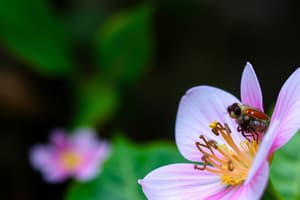Podcast
Questions and Answers
What type of eggs do reptiles lay?
What type of eggs do reptiles lay?
- Hard shell eggs
- Soft shell eggs (correct)
- Liquid shell eggs
- No eggs
Which vertebrates are characterized as warm-blooded?
Which vertebrates are characterized as warm-blooded?
- Amphibians and mammals
- Birds and reptiles
- Fish and amphibians
- Mammals and birds (correct)
How do amphibians breathe during their adult stage?
How do amphibians breathe during their adult stage?
- Through both gills and lungs
- Through skin only
- Through gills
- Through lungs (correct)
What is an extra characteristic unique to mammals?
What is an extra characteristic unique to mammals?
Which of the following is true concerning fish?
Which of the following is true concerning fish?
What happens to a plant cell placed in a concentrated solution?
What happens to a plant cell placed in a concentrated solution?
How does high temperature affect enzyme activity?
How does high temperature affect enzyme activity?
Which of the following correctly describes the behavior of a cell in an isotonic solution?
Which of the following correctly describes the behavior of a cell in an isotonic solution?
What do the nitrogenous base pairings in DNA signify?
What do the nitrogenous base pairings in DNA signify?
What is the result of an enzyme being denatured?
What is the result of an enzyme being denatured?
What is the primary function of enzymes in biological systems?
What is the primary function of enzymes in biological systems?
What is the correct definition of osmosis?
What is the correct definition of osmosis?
Which of the following best describes active transport?
Which of the following best describes active transport?
What characterizes the growth of an organism?
What characterizes the growth of an organism?
Which statement best defines a species?
Which statement best defines a species?
What is the role of diffusion in biological systems?
What is the role of diffusion in biological systems?
What is the outcome of excretion in living organisms?
What is the outcome of excretion in living organisms?
What is the primary difference in the number of floral parts between monocots and dicots?
What is the primary difference in the number of floral parts between monocots and dicots?
Which statement describes a tissue?
Which statement describes a tissue?
Which of the following organisms has a cell wall made of cellulose?
Which of the following organisms has a cell wall made of cellulose?
In terms of body segmentation, which group has many similar segments?
In terms of body segmentation, which group has many similar segments?
What is a characteristic of the vein structure in dicots?
What is a characteristic of the vein structure in dicots?
Which of the following tests requires heat to show a positive result?
Which of the following tests requires heat to show a positive result?
How is a positive result for the reduction of sugars identified in the Benedict's Test?
How is a positive result for the reduction of sugars identified in the Benedict's Test?
What type of cell has no permanent vacuole?
What type of cell has no permanent vacuole?
Which type of cellular structures are present in bacterial cells but not in animal cells?
Which type of cellular structures are present in bacterial cells but not in animal cells?
What is the primary component that makes up the plant cell wall?
What is the primary component that makes up the plant cell wall?
Which of the following processes requires energy?
Which of the following processes requires energy?
In a dilute solution, how does water move in plant cells?
In a dilute solution, how does water move in plant cells?
Which small molecule is produced from the breakdown of starch by amylase?
Which small molecule is produced from the breakdown of starch by amylase?
What universal factor affects the rate of diffusion by increasing it?
What universal factor affects the rate of diffusion by increasing it?
Which of the following statements is true about osmosis?
Which of the following statements is true about osmosis?
What is the stored form of carbohydrates in the animal liver?
What is the stored form of carbohydrates in the animal liver?
What components make up a lipid?
What components make up a lipid?
Flashcards
Warm blooded
Warm blooded
Animals like mammals and birds that can maintain a constant body temperature regardless of the environment.
Cold blooded
Cold blooded
Animals like reptiles, amphibians, and fish that rely on external sources like the sun to regulate their body temperature.
Exoskeleton
Exoskeleton
A hard outer covering that protects and supports the body of an animal.
Jointed legs
Jointed legs
Signup and view all the flashcards
Body segments
Body segments
Signup and view all the flashcards
Diffusion
Diffusion
Signup and view all the flashcards
Osmosis
Osmosis
Signup and view all the flashcards
Active transport
Active transport
Signup and view all the flashcards
Enzymes
Enzymes
Signup and view all the flashcards
Catalyst
Catalyst
Signup and view all the flashcards
Sensitivity
Sensitivity
Signup and view all the flashcards
Tissue
Tissue
Signup and view all the flashcards
Organ
Organ
Signup and view all the flashcards
What are large molecules?
What are large molecules?
Signup and view all the flashcards
What is a monomer?
What is a monomer?
Signup and view all the flashcards
What is hydrolysis?
What is hydrolysis?
Signup and view all the flashcards
What is condensation?
What is condensation?
Signup and view all the flashcards
What is diffusion?
What is diffusion?
Signup and view all the flashcards
What is osmosis?
What is osmosis?
Signup and view all the flashcards
What is active transport?
What is active transport?
Signup and view all the flashcards
What are enzymes?
What are enzymes?
Signup and view all the flashcards
Cell Shrinkage (in Hypertonic Solution)
Cell Shrinkage (in Hypertonic Solution)
Signup and view all the flashcards
Turgor Pressure
Turgor Pressure
Signup and view all the flashcards
Isotonic Solution
Isotonic Solution
Signup and view all the flashcards
Enzyme Denaturation
Enzyme Denaturation
Signup and view all the flashcards
Active Site
Active Site
Signup and view all the flashcards
Insects
Insects
Signup and view all the flashcards
Arachnids
Arachnids
Signup and view all the flashcards
Crustaceans
Crustaceans
Signup and view all the flashcards
Myriapods
Myriapods
Signup and view all the flashcards
Monocot
Monocot
Signup and view all the flashcards
Dicot
Dicot
Signup and view all the flashcards
Plant Cell
Plant Cell
Signup and view all the flashcards
Animal Cell
Animal Cell
Signup and view all the flashcards
Study Notes
Biology Revision Midterm - Grade 9
- Important Definitions
- Movement: An action by an organism or its part resulting in a change of location.
- Respiration: Chemical processes in living cells that release energy from nutrients.
- Sensitivity: The ability to detect and respond to stimuli.
- Growth: Increase in size and/or dry mass.
- Reproduction: Processes creating new organisms of the same kind.
- Excretion: Removal of waste products.
- Nutrition: Taking in materials for energy and development.
- Species: Group of organisms capable of interbreeding to produce fertile offspring.
- Tissue: Group of similar cells with a shared function.
- Organ: Group of different tissues functioning together.
- Diffusion: Net movement of particles from high concentration to low concentration.
- Osmosis: Net movement of water across a partially permeable membrane from high water potential to low water potential.
- Active Transport: Movement of particles across a cell membrane against the concentration gradient, requiring energy from respiration.
- Enzymes: Protein catalysts speeding up metabolic reactions without being consumed.
- Catalyst: Any substance that increases the rate of a chemical reaction without being consumed.
Comparisons of Vertebrates
- Vertebrates possess a backbone
- Different categories like Mammals, Birds, Reptiles, Amphibians, and Fish have distinct characteristics
- Mammals: Fur/hair, live birth, lungs. Warm-blooded (endothermic)
- Birds: Feathers, lay hard-shelled eggs, lungs, warm-blooded (endothermic)
- Reptiles: Dry scales, lay eggs on land, lungs. Cold-blooded (ectothermic)
- Amphibians: Smooth, moist skin, lay eggs without shell. Breathe through lungs and skin in adults, metamorphosis. Cold-blooded (ectothermic)
- Fish: Wet scales, lay eggs without shell, breathe through gills. Cold-blooded (ectothermic)
Comparisons of Arthropods
- Arthropods are characterized by exoskeletons, jointed legs, and segmented bodies.
- Categories include Insects, Arachnids, Crustaceans, and Myriapods
- Insects: 3 pairs of legs, 1 pair of antennae, 3 body segments (head, thorax, abdomen).
- Arachnids: 4 pairs of legs, usually no antennae, 2 body segments (cephalothorax, abdomen).
- Crustaceans: More than 4 pairs of legs, 2 pairs of antennae, usually 2 body segments.
- Myriapods: Many pairs of legs, 1 pair of antennae, many body segments.
Comparisons of Monocot and Dicot Plants
- Monocots: 3 or multiples of 3 floral parts, parallel veins, 1 cotyledon.
- Dicots: 4/5 or multiples of 4/5 floral parts, reticulated/branched veins, 2 cotyledons.
Comparisons of Plant, Animal, and Bacterial Cells
- Plant cells: Cell wall (cellulose), chloroplasts, large vacuole.
- Animal cells: No cell wall, no chloroplasts, small or absent vacuoles.
- Bacterial cells: Cell wall (not cellulose), no chloroplasts, no membrane-bound organelles.
Tests for Biological Molecules
- Benedict's test: Detects reducing sugars (e.g., glucose.) Positive results range from brick red (high concentration) to green/yellow/orange (lower concentration)
- Iodine test: Detects starch. Positive result is a blue-black color.
- Biuret test: Detects proteins. Positive result is a purple color.
- Ethanol test: Detects lipids. A cloudy/milky emulsion indicates positive results for lipids/fats
Large and Small Molecules
- Large Molecules: Cells are formed by polymers of smaller molecules, e.g., cellulose, glycogen, starch, proteins, and lipids.
- Small Molecules: e.g., glucose, amino acids, fatty acids, glycerol. These are the building blocks.
Comparison of Diffusion, Osmosis, and Active Transport
- Diffusion is the movement of substances/particles from a high concentration area to a low concentration area. No energy required.
- Osmosis is the net movement of water from a high water potential area to a low water potential area across a semi-permeable membrane. No energy required.
- Active transport is the movement of substances against the concentration gradient from a low concentration to a high concentration area. Energy required from respiration.
Factors Affecting Enzyme Activity
- Temperature: Optimal temperature exists for enzyme activity. High temperatures cause denaturation (loss of shape).
- pH: Enzymes have an optimal pH range. Deviations cause denaturation.
Magnification
- Magnification (M) = Image size (I) / Actual size (A)
- Image size = Magnification x Actual size.
Plant and Animal Cell Structure and Function
- Nucleus: Contains DNA, controls cell activities.
- Cytoplasm: Gel-like substance, supports internal structures, many reactions occur here.
- Cell Membrane: Surrounds the cell, controls entry/exit of substances.
- Ribosomes: Site of protein synthesis.
- Mitochondria: Site of aerobic respiration, generates energy.
- Chloroplast: Site of photosynthesis, absorbs light energy.
- Cell Wall: Provides support and shape in plant cells (made of cellulose).
- Vacuole: Stores substances, helps maintain cell shape, most prominent in plant cells (contains cell sap)
Studying That Suits You
Use AI to generate personalized quizzes and flashcards to suit your learning preferences.




